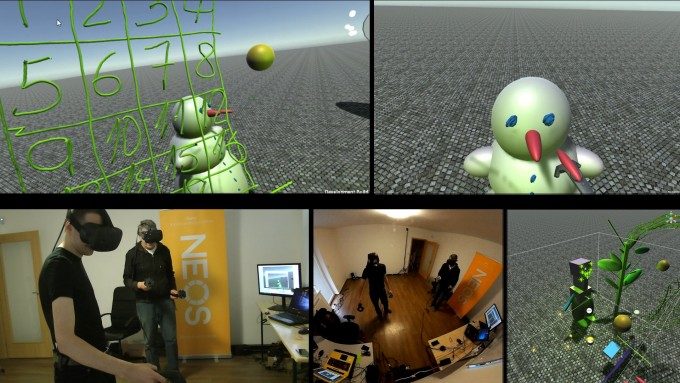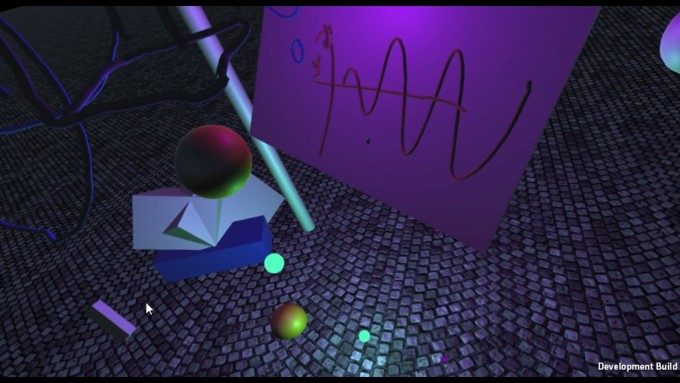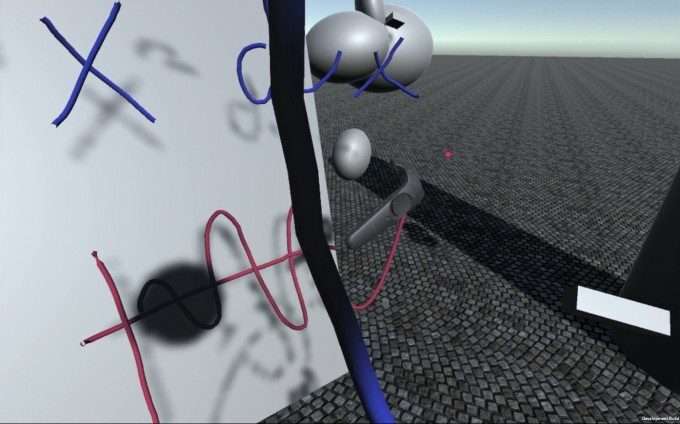Tomáš ‘Frooxius’ Mariančík, the man behind the Sightline series has reached what he calls a “major milestone” with his continuing creation and education platform Neos. Today he unveiled a breakthrough framework which allows multiple users to gaze into and collaborate in the virtual world through VR headsets and portable devices.
Neos Core is the latest innovation from Tomáš ‘Frooxius’ Mariančík and it’s more significant a development than it might first appear. The new framework Mariančík has constructed is the bedrock of a multi-user, multi-device capable VR system which allows anyone to interact, collaborate and build inside a network synced virtual reality through VR headsets, phones and tablets.
See Also: ‘Sightline’ Dev Wants You to Build the Metaverse with ‘NEOS’, First Gameplay Video Revealed
The latest video from the developer gives a glimpse at a very early demo, built atop that new Neos Core framework. The demo, which Mariančík claims only took a day to construct, has 3 users – 2 wearing HTC Vive headsets wielding SteamVR controllers and one on an Android mobile device. Whilst the two VR headset wearers collaborate on building their bizarre creations, the user on the mobile device peers in, using the phone as a window into the space – ready to help out.
Neos Core, the underlying framework to Neos, enables a truly collaborative environment for productivity and is designed to be abstract in nature. So, for example, you could build a tool in VR which another user can then use to build a specific object or location. “…its designed to handle many different kinds of content and we want to make it accessible for people to create and share whatever they want/need,” Mariančík tells me, “It’s designed to be more generic, like Unity engine for example. It’s a tool that allows you to build all kinds of interactive applications, whether it’s variety of games, medical visualization, chemical, physics sandbox, virtual presentation and so on, or some cool visualization. It’s a bit like that, but designed for VR from ground up with more natural tools (that can’t be seen yet) and automatically synchronized/collaborative (that’s what the video is about, testing the underlying system for that).”
Aside from the raw, technical challenges associated with pulling off this sort of synchronisation, Mariančík claims conceptualising the building blocks to piece Neos Core together was the biggest challenge. “It was really difficult, especially conceptually,” Mariančík tells me, “finding a set of basic elements for the system that are neat, elegant, generic and yet able to handle pretty much anything I throw at them. But I’m really excited because I did and it’s all coming together now.”
“It uses Unity engine for rendering, physics, audio and overall, but it has its own object and update system (although it’s largely inspired by Unity), that’s designed to be fundamentally synchronizable,” Mariančík told /r/oculus users, “It’s actually quite modular, so porting it to other engines would be relatively easy. It uses something I call Data-Connector-Implementer model, so porting it to another engine would be matter of writing engine-specific implementers.”
It’s impressive stuff, with an impressively vast scope for application, and you can see why Mariančík is so excited about the possibilities Neos could unlock.
But what of connecting teams of workers from different towns or countries over networks and placing them in a collaborative, virtual space? “We didn’t do any tests over large distances yet, only local Wi-Fi at this point, but that’s going to come. You can see in the video that we have two laptops, each driving one Vive headset. There’s also Android phone that joins in the middle of session and displays what’s going on in the virtual environment and a MS Surface also showing what’s going on, connected to the session over Wi-Fi.”
But how will Neos work as a commercial entity? Mariančík has a grand vision of how it’ll be structured. “Neos Core is just the underlying framework of Neos itself, which will be available to the developers and users alike. It makes no distinction between creating and consuming from technical standpoint – you create, share and experience from the same runtime, which will be available freely.” Mariančík says, “What you’ll pay for are services – server runtime, hosting, support, computing time, etc.”
It’s early days just yet, but when you wrap your head around Mariančík’s vision, it not only makes sense, you immediately begin to imagine what you, as part of a team, could achieve inside this intuitive, collaborative space – once which you might share with anyone, no matter where they are in the world. It’s one of those ideas that acts as a reminder of VR’s potential scope to change everything, and I’m looking forward to my first Neos session.









